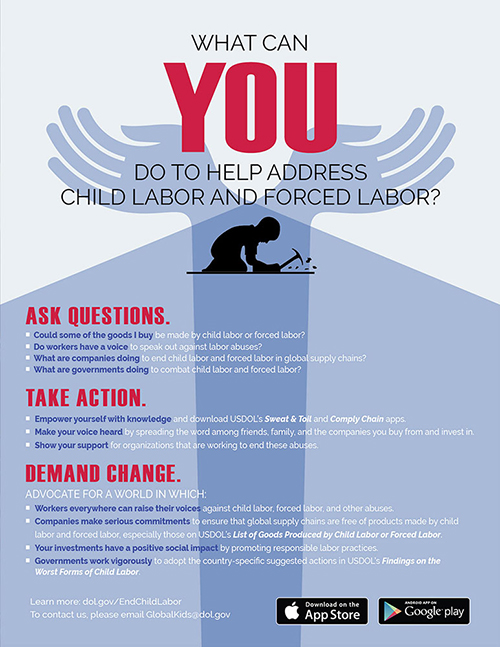List of Goods Produced by Child Labor or Forced Labor
The Bureau of International Labor Affairs (ILAB) maintains a list of goods and their source countries which it has reason to believe are produced by child labor or forced labor in violation of international standards, as required under the Trafficking Victims Protection Reauthorization Act (TVPRA) of 2005 and subsequent reauthorizations. The List of Goods Produced by Child Labor or Forced Labor comprises 159 goods from 78 countries and areas, as of September 28, 2022.
ILAB maintains the List primarily to raise public awareness about forced labor and child labor around the world and to promote efforts to combat them; it is not intended to be punitive, but rather to serve as a catalyst for more strategic and focused coordination and collaboration among those working to address these problems.
Publication of the List has resulted in new opportunities for ILAB to engage with foreign governments to combat forced labor and child labor. It is also a valuable resource for researchers, advocacy organizations and companies wishing to carry out risk assessments and engage in due diligence on labor rights in their supply chains.
The countries on the List span every region of the world. The most common agricultural goods listed are sugarcane, cotton, coffee, tobacco, cattle, rice, and fish. In the manufacturing sector, bricks, garments, textiles, footwear, carpets, and fireworks appear most frequently. In mined or quarried goods, gold, coal and diamonds are most common.
ILAB published the initial TVPRA List in 2009 and updated it annually through 2014, following a set of procedural guidelines that were the product of an intensive public consultation process. ILAB now updates and publishes the List every other year, pursuant to changes in the law.
Procedural Guidelines
On January 25, 2024, ILAB's Office of Child Labor, Forced Labor, and Human Trafficking published Procedural Guidelines for the development and maintenance of the List of Goods from countries produced by child labor or forced labor in violation of international standards.
| Country/Area | Good Sort ascending | Exploitation Type |
|---|---|---|
| Bolivia | Child Labor | |
| India | Child Labor | |
| India | Child Labor | |
| Uzbekistan | There are reports that adults are forced to cultivate silk cocoons in Uzbekistan. A silk cocoon is the protective casing a silkworm spins around itself before metamorphosing into a moth. Silk cocoons can be processed and unwound to produce silk thread. Forced labor in cocoon production predominantly occurs among farmers in the south of the country, although evidence suggests that other rural families are also subjected to forced labor in this sector. Based on estimates from the Uzbek-German Forum, a majority of the over 45,000 farmers in Uzbekistan who produce silk cocoons each year do not have the freedom to refuse this work; they are compelled to perform it by government officials. Regional- and district-level officials assign each farmer a quota for the production of silk cocoons, and threaten farmers with fines, the loss of their leased farmland, or physical violence if they fail to meet the quota. Farmers are required to sell their silk cocoons back to the government at an official procurement price, which can be too low to offset the cost of cultivating the cocoons, and often experience underpayment, delayed payment, or receive no payment at all. Regional- and district-level governments also impose quotas on neighborhood councils called mahallas, which use their authority over distribution of social benefit payments to force neighborhood residents to cultivate silk cocoons. Because silkworms require constant attention and the maintenance of a carefully controlled environment in order to survive, farmers and rural families often cultivate cocoons in several rooms of their own homes and many work more than 20 hours a day during the approximately month-long cultivation period. |
Forced Labor |
| Bangladesh | Child Labor | |
| Burma | Forced Labor | |
| Cambodia | Child Labor | |
| Thailand | There are reports that children are forced to process shrimp in Thailand. Burmese and Cambodian immigrants are particularly vulnerable to forced child labor in the shrimp industry. A UN report identified approximately 150 children working, many alongside their mothers, in Klong Yai district near the Cambodia border. Children are often forced to peel and sort shrimp. Some are forced to work long hours without breaks, physically abused, and prohibited from leaving the worksite. They frequently have their identity documents confiscated by their employers. In some cases, child workers are paid little, if at all, and their wages are deducted to repay debts related to recruitment, food, and/or lodging. The children often endure these conditions under the threat of dismissal and arrest by immigration police.
|
Child Labor, Forced Labor |
| El Salvador | Child Labor | |
| Nicaragua | Child Labor |
your hand? Download ILAB's Sweat & Toil App today!
Are you a company looking to fight child labor and forced labor in supply
chains?





